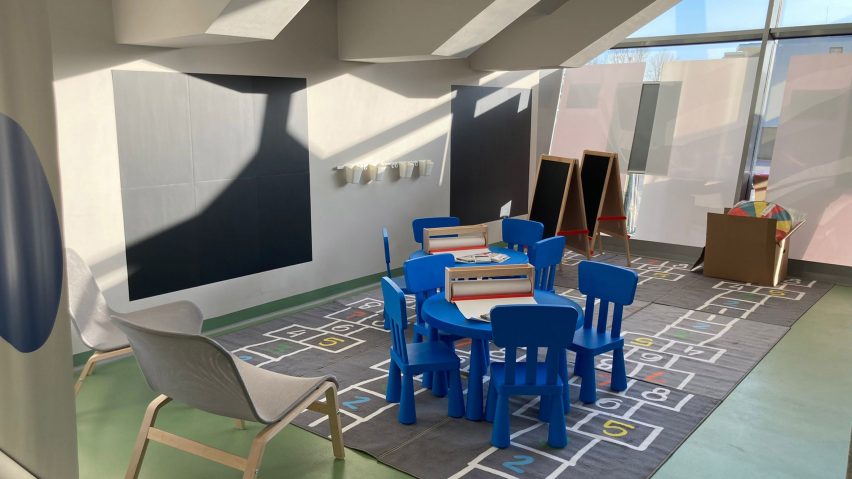Furniture company IKEA has donated its products and design services to create a series of refugee support centres in Eastern Europe, set up by the United Nations to offer aid and sanctuary to the most vulnerable groups displaced by Russia's invasion of Ukraine.
The Swedish furniture brand created interiors with a homely, comforting atmosphere inside several recently established Blue Dot centres, which are run by the United Nations Children's Fund (UNICEF) and the UN Refugee Agency UNHCR to offer specialist support to children, families and other at-risk refugees.
Set alongside major border crossings and transit routes, the centres supply legal aid, mental health support and family reunification services, as well as food and temporary shelter.
"The work calls for a whole new set of skills because we're designing spaces that can support people who are experiencing trauma," said Martyna Pater, who is an interior design specialist for IKEA in Kraków, Poland.
"We're using walls made of Kallax shelving units and thick curtains to create a quieter and more comfortable environment, to make it feel more like a home, and we've also used decorations and picture frames, to make the space feel as cosy and calm as possible."
6.9 million people have fled Ukraine
Out of the 36 Blue Dot centres that UNICEF and UNHCR have established across seven European countries since the start of the Ukraine war, IKEA has helped to design 10 in Romania and five in Poland.
Three more are currently in development and plans are in the making for IKEA to help set up of additional outposts in Hungary and Slovakia.
The initiative forms part of a wider €1 million donation that IKEA has pledged to UNICEF and UNHCR's emergency relief efforts for the Ukraine war, with an additional €30 million going to other selected organisations.
The furniture company previously joined a number of brands and studios in pausing its operations in Russia, closing its stores and halting imports and exports from the country.
Since the war started in February, more than 6.9 million people have fled Ukraine – 90 per cent of which are women and children, who UNICEF says are especially at risk of abuse, exploitation and trafficking.
Blue Dot centres, which were first established in 2016, are designed to provide "safe spaces" for these vulnerable groups, containing playrooms for children, private areas for mental health counselling and safe places to sleep.
"By far, most of the refugees who have fled unimaginable loss and devastation in Ukraine are women, children and older people or people with disabilities, in need of dedicated support," said Marin Din Kajdomcaj, Poland's representative at the UN Refugee Agency.
"Thanks to our great collaboration with IKEA, we can design comforting Blue Dot spaces where refugees at greater risk can find a moment to rest, feel safe and protected again, access reliable information, counselling and psychological support, all in an effort to have them start healing and recovering from traumatising events."
Shelters designed to be convenient, child-friendly and site-specific
For IKEA's design teams, this involved creating interiors that are easy to navigate and tailored to both adults and children alike.
"We're designing spaces for children that are cosy and playful, but we use low furniture so their parents can see them when they are speaking to advisors," Pater explained.
"With thousands of people coming to the hubs, you also have to think about crowd control and creating good signage that helps people move through the space so they can find the right support they need."
Since Blue Dot shelters are temporary, they occupy a wide range of settings from tents to repurposed arenas.
As a result, IKEA's designers developed tailored interiors schemes that respond to specific sites and scales, rather than coming up with a universal template.
"It's all about a fast response and providing a comfortable safe space," said Laurentiu Stefan Serban, a visual merchandiser and shop designer for IKEA in Bucharest, Romania. "The aim is to create an environment where people can recover and find their strengths again."
A number of architects have applied their expertise to creating temporary shelters for those displaced by the Ukraine war.
Kyiv practice Balbek Bureau developed a concept for a modular refugee village, which was picked up by Ukrainian president Volodymyr Zelensky and is now set to be constructed in the country's Ternopil region.
Pritzker Prize-winning architect Shigeru Ban focused instead on creating more privacy in existing shelters by making use of his modular Paper Partition System, which can be constructed from cardboard tubes and strips of fabric in around five minutes.
The images are courtesy of IKEA.

